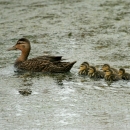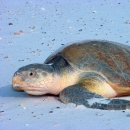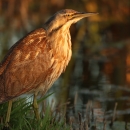Seasons of Wildlife
Wintering waterfowl at the Cocklebur Slough Recreation Area: November - February
Wintering forest songbirds: October – March
Migrating songbirds: October – early November for fall, late March – early May for spring
Resident water birds, mammals and reptiles: Year-around
Featured Species
Gazing across the refuge’s pristine marshes, sloughs, expansive uplands and into the woodlands, it is easy to imagine Texas as it was before settlement. Clouds of snow geese in the winter or warbler “fallouts” in the spring further convince visitors they have stepped back in time.
The area’s mild temperatures and moisture from the Gulf create an environment enticing to resident and migratory wildlife. San Bernard supports a diversity of coastal wildlife, including more than 320 species of birds, 95 species of reptiles and amphibians, and 450 species of butterflies and dragonflies.
The refuge boundary starts where the Gulf of America meets the shore. Countless migrating and nesting shorebirds, including the endangered piping plover, share this shoreline with nesting Kemp’s Ridley sea turtles. The beaches’ dunes not only support a diversity of wildlife, they also provide a buffer to the bordering bay estuaries and saltwater marshes. These watery ecosystems sustain massive oyster beds and serve as nurseries for shellfish and finfish, an important source of food for great blue herons, roseate spoonbills, and wood storks. Recreationally important fish species, like red drum, speckled trout and gulf flounder, encircle the small islands crowded with nesting colonial waterbirds including black skimmers and reddish egrets.
Moving inland, the salty environment is diluted by the rivers and rainfall and the landscape is transformed into freshwater marshes, ponds and winding bayous. Here, emergent wetlands with cattails and rushes support purple gallinules, bitterns, frogs, crawfish, and alligators that sun themselves on the banks. Thousands of waterfowl fill these wetlands where they feed and rest, build up the reserves needed for a winter stay or to complete their migration.
The change in salinity and elevation is especially reflected in the plant community. The diverse wetland habitat slowly blends into coastal prairie, shifting from smooth cordgrass and sea ox-eye daisy to Olney bulrush and baccharis. Eventually, the prairie’s switchgrass and blue stem species give way to the habitat for which the refuge is best known, the Columbia bottomlands.
These dense woods are made up of massive live oaks, green ash, hackberry, and pecan trees that follow the region’s rivers and sloughs. The forests undergo seasonal flooding and are essential habitat for wintering and migrating passerines. Exhausted from their flight across the Gulf, neotropical migratory birds depend on the bottomlands as a place to rest, feed and refuel before continuing their migration. The bottomland hardwood forests are in the floodplain of the Brazos, San Bernard and Colorado Rivers, all of which slowly work their way down the landscape to empty into the Gulf.










